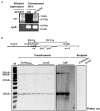Incidence and Effects of Acquisition of the Phage-Encoded ssa Superantigen Gene in Invasive Group A Streptococcus
- PMID: 34149675
- PMCID: PMC8212969
- DOI: 10.3389/fmicb.2021.685343
Incidence and Effects of Acquisition of the Phage-Encoded ssa Superantigen Gene in Invasive Group A Streptococcus
Abstract
The acquisition of the phage-encoded superantigen ssa by scarlet fever-associated group A Streptococcus (Streptococcus pyogenes, GAS) is found in North Asia. Nonetheless, the impact of acquiring ssa by GAS in invasive infections is unclear. This study initially analyzed the prevalence of ssa+ GAS among isolates from sterile tissues and blood. Among 220 isolates in northern Taiwan, the prevalence of ssa+ isolates increased from 1.5% in 2008-2010 to 40% in 2017-2019. Spontaneous mutations in covR/covS, which result in the functional loss of capacity to phosphorylate CovR, are frequently recovered from GAS invasive infection cases. Consistent with this, Phostag western blot results indicated that among the invasive infection isolates studied, 10% of the ssa+ isolates lacked detectable phosphorylated CovR. Transcription of ssa is upregulated in the covS mutant. Furthermore, in emm1 and emm12 covS mutants, ssa deletion significantly reduced their capacity to grow in human whole blood. Finally, this study showed that the ssa gene could be transferred from emm12-type isolates to the emm1-type wild-type strain and covS mutants through phage infection and lysogenic conversion. As the prevalence of ssa+ isolates increased significantly, the role of streptococcal superantigen in GAS pathogenesis, particularly in invasive covR/covS mutants, should be further analyzed.
Keywords: CovR/CovS; SSA; group A Streptococcus; invasive GAS infection; streptococcal superantigen; superantigen.
Copyright © 2021 Chiang-Ni, Liu, Lin, Hsu, Shi, Chen, Lai and Chiu.
Conflict of interest statement
The authors declare that the research was conducted in the absence of any commercial or financial relationships that could be construed as a potential conflict of interest.
Figures




Similar articles
-
The Bacterial Markers of Identification of Invasive CovR/CovS-Inactivated Group A Streptococcus.Microbiol Spectr. 2022 Oct 26;10(5):e0203322. doi: 10.1128/spectrum.02033-22. Epub 2022 Oct 6. Microbiol Spectr. 2022. PMID: 36200903 Free PMC article.
-
RocA Regulates Phosphatase Activity of Virulence Sensor CovS of Group A Streptococcus in Growth Phase- and pH-Dependent Manners.mSphere. 2020 May 20;5(3):e00361-20. doi: 10.1128/mSphere.00361-20. mSphere. 2020. PMID: 32434842 Free PMC article.
-
Phosphorylation at the D53 but Not the T65 Residue of CovR Determines the Repression of rgg and speB Transcription in emm1- and emm49-Type Group A Streptococci.J Bacteriol. 2019 Jan 28;201(4):e00681-18. doi: 10.1128/JB.00681-18. Print 2019 Feb 15. J Bacteriol. 2019. PMID: 30478086 Free PMC article.
-
Contemporary Pharyngeal and Invasive emm1 and Invasive emm12 Group A Streptococcus Isolates Exhibit Similar In Vivo Selection for CovRS Mutants in Mice.PLoS One. 2016 Sep 9;11(9):e0162742. doi: 10.1371/journal.pone.0162742. eCollection 2016. PLoS One. 2016. PMID: 27611332 Free PMC article.
-
Analysis of the role of CovR and CovS in the dissemination of Streptococcus pyogenes in invasive skin disease.Microb Pathog. 2006 May;40(5):221-7. doi: 10.1016/j.micpath.2006.01.005. Epub 2006 Mar 20. Microb Pathog. 2006. PMID: 16542816
Cited by
-
The Bacterial Markers of Identification of Invasive CovR/CovS-Inactivated Group A Streptococcus.Microbiol Spectr. 2022 Oct 26;10(5):e0203322. doi: 10.1128/spectrum.02033-22. Epub 2022 Oct 6. Microbiol Spectr. 2022. PMID: 36200903 Free PMC article.
References
LinkOut - more resources
Full Text Sources
Research Materials

